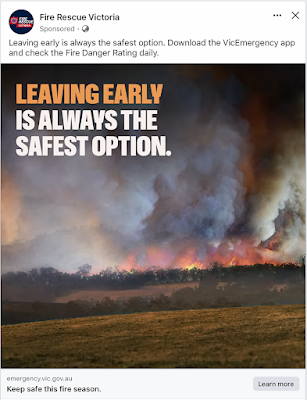This blog posting is headed “Bushfire: Failure of governments” — I have assessed the performance of governments and their responsible agencies going back as far as the Ash Wednesday 1983 bushfires, particularly as they impacted Victoria, as I consider those fires to be the modern historical base of major fires in this State.
Included in the posting is a reference to the report of the Bushfire Review Committee. It’s an interest read, including much about warnings, evacuation and sheltering — and acknowledges that some people might choose to remain and defend their homes.
And what did we learn from the cyclone? Lots of instructions were being given by emergency management agencies on what to do i.e. others were considering the welfare of communities considered to be at risk.
In theory fine for a cyclone but a bushfire is different!
Below in this posting people in Pomonal have expressed a desire to remain with their homes, and what are the emergency management agencies doing to help them prepare and support them if they are again confronted with bushfire, other than urging them to flee?
Out of the cyclone response was this statement from Queensland Premier reported in The Australian, “David Crisafulli’s bid to replace Covid-era fear with facts in Cyclone Alfred response”, dated 10 March 2025:
Mr Crisafulli insisted that households be given accurate, timely information and, wherever possible, be allowed to make their own decisions on what to do.
The messaging had to be precise and locally focused, reflecting Mr Crisafulli’s nuanced communications strategy during the cyclone emergency.
His crisp, businesslike manner was new to Queenslanders: less of the emotive language and hand-holding that past Labor premiers Anna Bligh and Annastacia Palaszczuk had deployed, more -emphasis on imparting the nuts and bolts information people needed to know about the events unfolding around them.
On Sunday, the LNP man donned a suit and tie to deliver televised updates on the unfolding disaster. “Instead of a top-down ¬approach of ordering people what to do, this has been about providing information from the bottom up, addressing challenges with the agencies and councils, and providing clear and detailed local messaging,” one senior government source said.
It's now approximately 11 weeks on from the 42nd anniversary of the 16 February (Ash Wednesday) 1983 bushfires in Victoria and South Australia and its worth looking back.
shows what remained of the main street of Macedon after the impact of the 1983 fire.
By this time Victoria was well into recording the details of its losses, including the 47 human lives taken by the fires. Reasonable to expect that the government's soon to be established Bushfire Review Committee members were assembling their thoughts and modus operandi – S.I.Miller, Chair; AVM W.Carter, Deputy Chairman and R.G.Stephens, Member.
And, what have we learned from the fires, in my opinion little or nothing if we consider the two recent Grampians fires.
A story by the ABC concerning declining mental health in Pomonal in the aftermath of the fires:
"There's a lot of stuff that's been suppressed over the past year, so that when we're back into the fire situation again it can be quite traumatic for people who lost properties or suffered through the Pomonal fires."
This so-far short year I've posted The Ides of Christmas in Victoria: Bushfire and the accompanying 'smokescreen' that is principally about difficulties obtaining bushfire insurance and Houses save people and people save houses about bushfire evacuation.
How's this for resilience A story by the ABC about Pomonal residents vowing to stay despite two bushfires in 12 months:
It's a stark contrast to 12 months ago when a dry lightning strike started a fire that ripped through the town, destroying 45 homes.
This summer fire again threatened the town, reigniting the fears and realities that come with living in the shadow of a national park.
Some residents have left, but many have stayed and are keen to rebuild their homes and lives.
They say the community is all the stronger for having survived two bushfires in 10 months.
To accommodate these people the emergency management agencies at all levels must move away from the current approach of frightening people from their homes to supporting them.
dated 29 December 2024























